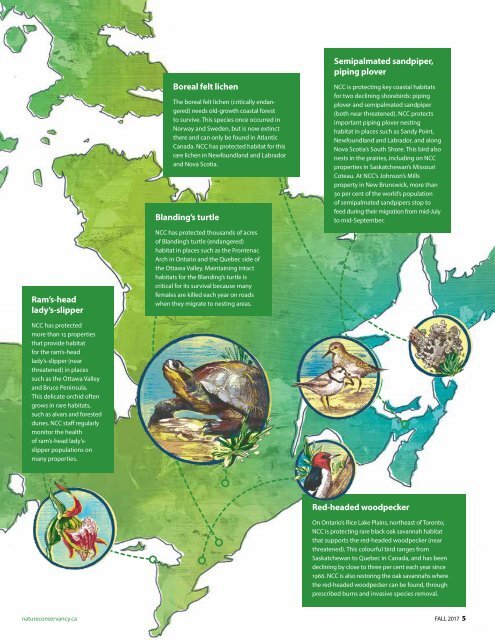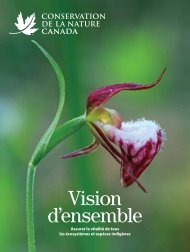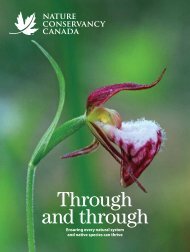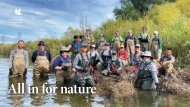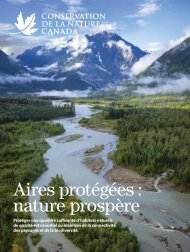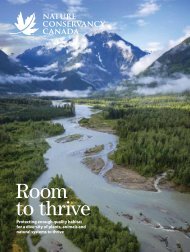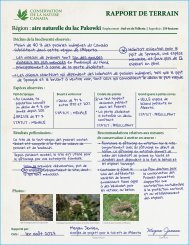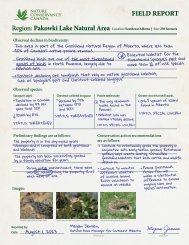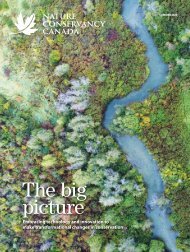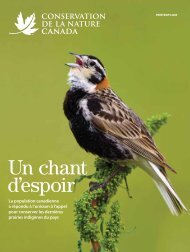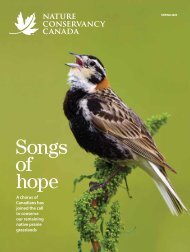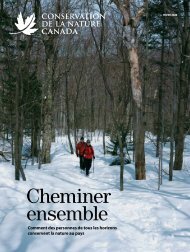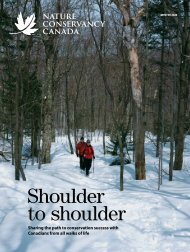NCC's 2017 fall magazine
You also want an ePaper? Increase the reach of your titles
YUMPU automatically turns print PDFs into web optimized ePapers that Google loves.
Ram’s-head<br />
lady’s-slipper<br />
NCC has protected<br />
more than 15 properties<br />
that provide habitat<br />
for the ram’s-head<br />
lady’s-slipper (near<br />
threatened) in places<br />
such as the Ottawa Valley<br />
and Bruce Peninsula.<br />
This delicate orchid often<br />
grows in rare habitats,<br />
such as alvars and forested<br />
dunes. NCC staff regularly<br />
monitor the health<br />
of ram’s-head lady’sslipper<br />
populations on<br />
many properties.<br />
Boreal felt lichen<br />
The boreal felt lichen (critically endangered)<br />
needs old-growth coastal forest<br />
to survive. This species once occurred in<br />
Norway and Sweden, but is now extinct<br />
there and can only be found in Atlantic<br />
Canada. NCC has protected habitat for this<br />
rare lichen in Newfoundland and Labrador<br />
and Nova Scotia.<br />
Blanding’s turtle<br />
NCC has protected thousands of acres<br />
of Blanding’s turtle (endangered)<br />
habitat in places such as the Frontenac<br />
Arch in Ontario and the Quebec side of<br />
the Ottawa Valley. Maintaining intact<br />
habitats for the Blanding’s turtle is<br />
critical for its survival because many<br />
females are killed each year on roads<br />
when they migrate to nesting areas.<br />
Semipalmated sandpiper,<br />
piping plover<br />
NCC is protecting key coastal habitats<br />
for two declining shorebirds: piping<br />
plover and semipalmated sandpiper<br />
(both near threatened). NCC protects<br />
important piping plover nesting<br />
habitat in places such as Sandy Point,<br />
Newfoundland and Labrador, and along<br />
Nova Scotia’s South Shore. This bird also<br />
nests in the prairies, including on NCC<br />
properties in Saskatchewan’s Missouri<br />
Coteau. At NCC’s Johnson’s Mills<br />
property in New Brunswick, more than<br />
30 per cent of the world’s population<br />
of semipalmated sandpipers stop to<br />
feed during their migration from mid-July<br />
to mid-September.<br />
Red-headed woodpecker<br />
On Ontario’s Rice Lake Plains, northeast of Toronto,<br />
NCC is protecting rare black oak savannah habitat<br />
that supports the red-headed woodpecker (near<br />
threatened). This colourful bird ranges from<br />
Saskatchewan to Quebec in Canada, and has been<br />
declining by close to three per cent each year since<br />
1966. NCC is also restoring the oak savannahs where<br />
the red-headed woodpecker can be found, through<br />
prescribed burns and invasive species removal.<br />
natureconservancy.ca<br />
FALL <strong>2017</strong> 5


